Last week, a new reverb hit the free plugin market: Stargazer by Linda Audio – a hybrid VST FX unit that is able to generate some pretty decent delays and shimmering effects. But how is it in comparison to the also recently published shimmer-style reverb Solaris by Adam Szabo? We shall find out.

Developer: Linda Audio
Supports: Windows (VST2, VST3 32bit / 64bit)
The Interface
Well, as far as the appearance of it and the overall aesthetics, I tend to think that a better job could have been done. The design is not bad by any means, and I actually think that the interface is practical and intuitive for the majority of it. But I also feel like it is somewhat lacking, and not sufficiently polished.
More specifically, I’m not very fond of this sky-blue lens flare type of background and the whole color scheme chosen. Since the plugin goes for a stellar kind of theme, as reflected in its name and overall branding, what I would do instead is choose a darker color as a base that’d more resemble the outer space – such as a very deep blue or some shade of black – which would automatically give the UI a more extravagant appeal.
The Features
Moving on from the looks, let’s talk about the features.
Stargazer’s GUI is divided into a couple of main sections. The first major section, starting from the top, is the delay (“Delay Network”). This is where you pretty much define the behavior of the delay effect and its duration. The second main section is essentially your shimmer generator, in which you do all the pitch-shifting and shimmering magic. The remaining sections are Modulation (chorus) and Gain (which controls the dry & wet input/output parameters).
As you would expect, the two major modules work perfectly in conjunction with each other. That is mainly due to the fact they are both based on the principles of granular synthesis.
The term “Granular Synthesis” refers to the technical process in which sound waves or samples are being separated into small segments (grains) in real time. These so-called “grains” can then be manipulated in a variety of different ways – like changing their original order, altering the pitch and even shortening or expanding their duration.
Thanks to this creative method, I would quickly discover that Stargazer is not only capable of generating impressive shimmering delays. It also has the ability to create some really cool time warping effects that are similar to PaulStretch (which is also partially based on the idea of granular synthesis). This stretched sounding effect has an ethereal choral sound that is a natural fit for ambient-style productions and anything new age/spiritual.
I insistently urge you to go for that 100% wet setting, just so you can hear what the plugin actually does to a given sound. I was able to get some really unique results with even the most bland sampled instruments.
Stargazer vs. Solaris: “Battle of the Shimmers”
So, what are the actual differences?
First of all, the resolutions. Solaris by Adam Szabo gets much more in-depth as far as the main shimmer module is concerned (and what it is able to do). Stargazer does it too, but only to some capacity, as it doesn’t seem to provide enough freedom and flexibility in the tonal aspect.
Stargazer’s only pitch-altering options are the single octave mode and the double-octave mode – which essentially applies two separate tones at the same time – being a higher octave of the incoming pitch (+12) and a lower one (-12).
And while Stargazer only proceeds to supply an octave up and an octave down as fixed tonality options, Solaris on the other hand has plenty more possibilities – like the ability to generate and apply whole-tones, half-tones and even quarter-tones.
What Solaris also provides, aside from its extensive shimmer effect, is an additional sound shaping utility – which is a vowel based formant filter effect. Stargazer does not have all of these, and only seems to focus on providing a good (yet relatively basic) shimmer that pairs well with a complementary delay.
To one’s surprise (or not), the sound quality of both plugins is actually not too far apart, and you could potentially achieve some very similar results with either one. Though, Stargazer does tend to sound a bit more raw and gritty at times (which is not necessarily a bad thing of course). It also has this quite bold voice-like undertone, while Solaris has a more of a clean, neutral sound.
On a broader perspective, Solaris seems to focus its energies a bit more into the sound design aspect and the functionality of its main shimmer module. Potentially, its extra tools and features could help one sculpt a more ideal shimmer and a more ideal sound.
The Verdict: Which one is better?
If you are looking for a quick and a little more upfront shimmer, I would suggest that you’d use Stargazer. At the end of the day, despite not having the “luxury” of Solaris and being a less of a finished product, Linda Audio’s delay/reverb is still a very decent and usable VST plugin effect.
Though, in case you’re looking for some higher resolutions and more advanced sound design options, then Solaris may be the more optimal choice for you. It all comes down to preference really, and I could even see myself using the both of them in given circumstances.
Because of the similar qualities that both plugins share (despite one having a bit more functions), it makes it kind of hard for me to choose one over the other. The obvious pick would be Solaris, though I don’t think it would be a fair thing to do since, ultimately, they both offer some quality sounding shimmers that do their jobs, each in its own unique way.




